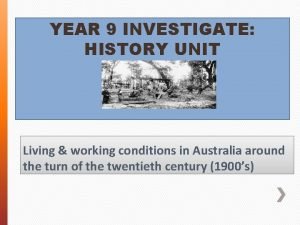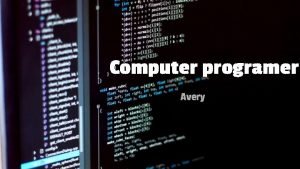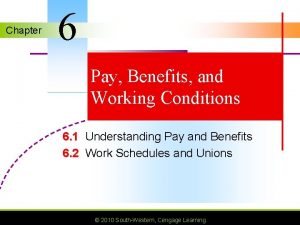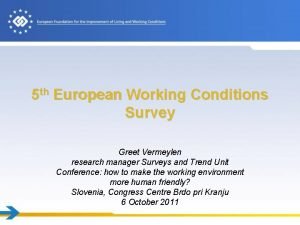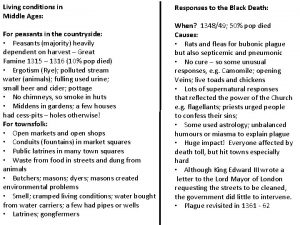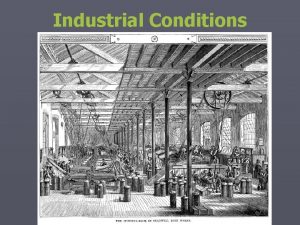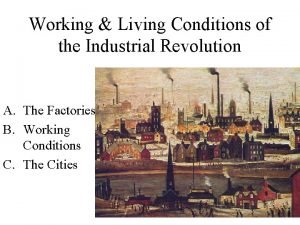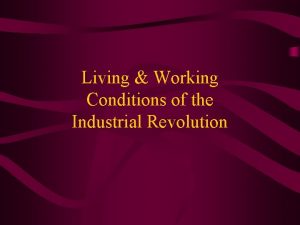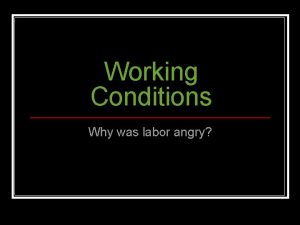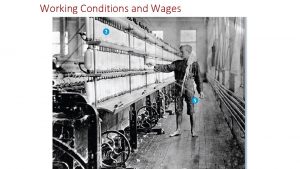Industrial Revolution 19 4 living working conditions Kiele













- Slides: 13

Industrial Revolution 19. 4 living & working conditions Kiele Brogan, Isaiah Kirtley, Dennis Decker, Mathew Reece

SWBAT- describe how different living and working conditions of the IR gave rise to the reform movement • Paid low wages, but needed high enough wages to support their families. • Control over their work hours.

Facts • Working conditions were terrible • People lived in a “slum” • Not much room for all people, people got sick • People worked from 14 -16 hours from 6 days a week • Women earned 1/3 of pay • Children worked 6 days a week, for 8 hours

Objective Review 1 • Question Explain Adam Smith’s “law of supply & demand” and “law of competition” work

Adam Smith Law of Supply and Demand • Profits and prices are fixed by the relationship of S&D • If an article is scarce and demand high profit/prices rise • When supply exceeds demand prices & profit fall Law of Competition • The least efficient business will go out of business • When manufactures quit producing the article, supply of the article will decrease • Well organized producers will make a reasonable profit

Objective Review 2 • Question Describe theory of Utilitarianism as social reform: The Greater Good

Utilitarianism: every act of a society should be judged in terms of its utility or usefulness • Jeremy Bentham • 1789 book- Introduction to the Principles of morals and Legislation • Good useful laws lead to “the greatest happiness of the greatest number” of people • People need education to know what Is good for them and makes them happy • Prison reform, Education reform, Legal reform • Government creates conditions to help as many people find happiness as possible

Objective Review 3 • Question • List and describe social reformers and the issue that reformer took.

Social Reformers and Issues Social reforms • Government needed to regulate work hours and set minimal wage Issues • Terrible issues in mines and factories • Children worked at the age of 9, from 8 hours a day, for 6 days a week.

Objective Review 4 • Question • Describe how workers tried to improve their situation.

How did workers improve the situation • Workers would go on strike but would still get paid • Workers would go on strike & make laws so woman and kids under 10 wouldn’t work in mines • Tried to improve their working conditions by getting into groups to collect, ?

slum • Industrial revolution changed families & lifestyle. • Poor people who worked in factories would live in a slum (a big building where lots of people lived) • Slums where over loaded • Not healthy • very dirty, messy • Families would have to live In one room.

Riots & Strikes • 100’s of strikes took place industrial countries during 1800’s. • Strikers made 2 types of demands, higher wages for workers and more control over working conditions. • Protest increased in size between 1811 -1834, demonstrations ended due to government sent troops to arrest.
 Capitalism def
Capitalism def Living and working conditions in australia 1900
Living and working conditions in australia 1900 What is the job description of a computer programmer
What is the job description of a computer programmer Kondisi kerja adalah
Kondisi kerja adalah Fair working conditions
Fair working conditions European working conditions survey 2020
European working conditions survey 2020 Chapter 6 pay benefits and working conditions
Chapter 6 pay benefits and working conditions European working conditions survey
European working conditions survey Living conditions in the middle ages
Living conditions in the middle ages Smart work and hard work
Smart work and hard work Hot working
Hot working Hot working and cold working difference
Hot working and cold working difference Differentiate between hot working and cold working
Differentiate between hot working and cold working Proses hot working
Proses hot working

